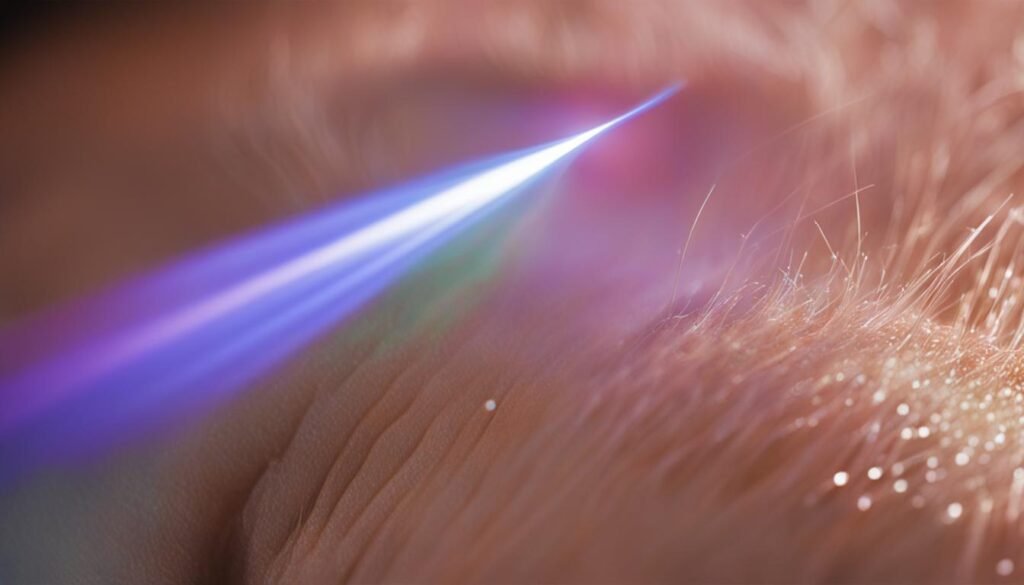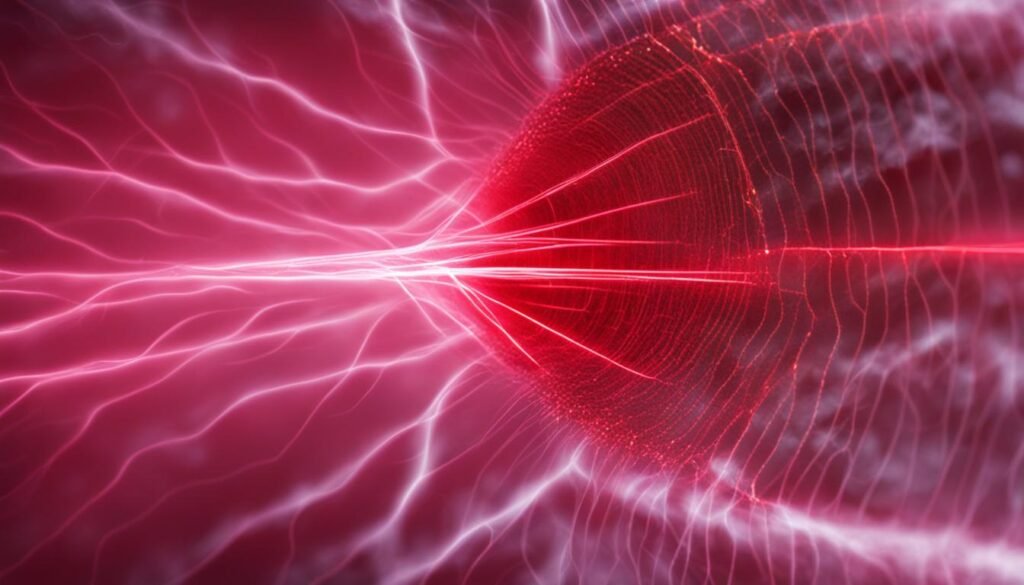Contents
- 1 Benefits and Common Treatment Locations
- 2 Hair Color and Skin Type Influence
- 3 Risks and Side Effects
- 4 Preparing for Laser Hair Removal
- 5 The Laser Hair Removal Procedure
- 6 Aftercare and Recovery
- 7 Home Laser Hair Removal Devices
- 8 Understanding Permanent Hair Reduction
- 9 Conclusion
- 10 FAQ
- 10.1 How does laser hair removal work?
- 10.2 What are the benefits of laser hair removal and where can it be used?
- 10.3 How does hair color and skin type influence the effectiveness of laser hair removal?
- 10.4 What are the risks and side effects of laser hair removal?
- 10.5 How can I prepare for laser hair removal?
- 10.6 What happens during the laser hair removal procedure?
- 10.7 What should I expect after laser hair removal?
- 10.8 Are home laser hair removal devices effective?
- 10.9 How does permanent hair reduction work?
- 10.10 Is laser hair removal a long-lasting alternative to shaving and waxing?
- 11 Source Links
Laser hair removal is a medical procedure that offers a convenient and long-lasting solution for unwanted hair. By utilizing a concentrated beam of light, the process targets hair follicles, inhibiting future hair growth. Let’s take a closer look at how this innovative treatment works.
Key Takeaways
- Laser hair removal is a medical procedure that uses a concentrated beam of light to remove unwanted hair.
- The laser targets the pigment in the hair, converting it to heat and damaging the hair follicles.
- Maintenance treatments are usually required for long-lasting results.
- Laser hair removal is effective for all skin types, but works best for those with light skin and dark hair.
- Consult with a qualified professional before undergoing laser hair removal to discuss risks, benefits, and expectations.
Benefits and Common Treatment Locations
Laser hair removal offers numerous benefits for individuals seeking a long-term solution for unwanted hair. The treatment targets specific areas, providing precision targeting that can remove hair from almost anywhere on the body. Some of the common treatment locations include:
- Legs: Laser hair removal can effectively remove hair from the legs, providing smooth and hair-free skin.
- Armpits: Say goodbye to shaving or waxing your underarms with laser hair removal.
- Upper lip: Removing unwanted hair from the upper lip area can be easily achieved with laser treatment.
- Chin: Laser hair removal can effectively target and remove hair from the chin area, providing a clean and smooth appearance.
- Bikini line: Laser hair removal is a popular choice for reducing unwanted hair along the bikini line, eliminating the need for frequent shaving or waxing.
One of the major advantages of laser hair removal is that it helps individuals avoid the awkward in-between growth stages that occur with other hair removal methods. With laser treatment, the hair follicles are damaged, leading to a decrease in hair growth. This means you can enjoy long, hair-free periods without the hassle of daily or weekly maintenance.
“Laser hair removal provides precision targeting and eliminates the need for constant maintenance.”
In addition, laser hair removal can help eliminate ingrown hairs, a common issue faced by individuals who shave or wax regularly. By targeting the hair follicles, laser treatment reduces the risk of ingrown hairs, leaving your skin smooth and free from painful bumps or redness.
| Treatment Location | Benefits |
|---|---|
| Legs | Smooth and hair-free skin |
| Armpits | No more shaving or waxing |
| Upper lip | Clean and hair-free upper lip |
| Chin | Smooth and hair-free chin area |
| Bikini line | Reduces the need for frequent shaving or waxing |
Hair Color and Skin Type Influence
The effectiveness of laser hair removal is greatly influenced by hair color and skin type. Since the laser targets the pigment in the hair, it tends to produce the best results on individuals with dark hair and light skin. This is because the contrast between the hair color and skin tone allows the laser to more efficiently target and destroy the hair follicles.
On the other hand, individuals with light-colored hair, such as gray, red, blond, and white, may experience less effective results with laser hair removal. Light-colored hair has less pigment, making it more challenging for the laser to effectively target and damage the hair follicles.
However, it is important to note that advancements in laser technology have made it possible to treat darker skin tones with laser hair removal. Specialized lasers that emit longer wavelengths are used to safely target the hair follicles without damaging the surrounding skin.
When considering laser hair removal, it is recommended to consult with a qualified professional who can assess your hair color and skin type to determine the most suitable treatment plan for you.
Risks and Side Effects
While laser hair removal is generally safe and effective, it is important to be aware of the potential risks and side effects associated with the procedure. Understanding these risks will help you make an informed decision about whether laser hair removal is the right choice for you.
Risks:
1. Skin Damage: Although rare, laser hair removal can cause skin damage, including burns, blisters, or changes in skin texture. This risk can be minimized by choosing a qualified and experienced medical professional to perform the procedure.
2. Eye Injury: Laser hair removal should not be performed on or near the eyelids or eyebrows due to the risk of eye injury. Protective eyewear should always be worn during the procedure to ensure the safety of both the patient and the practitioner.
3. Infection: In rare cases, laser hair removal can lead to infections, especially if proper hygiene and sterilization procedures are not followed. It is important to choose a reputable clinic or medical facility that maintains high standards of cleanliness.
4. Hyperpigmentation or Hypopigmentation: Laser hair removal can sometimes cause changes in skin pigment, resulting in areas of darker or lighter skin. These changes are usually temporary, but they can be long-lasting or permanent in rare cases.
Side Effects:
1. Temporary Discomfort: During the laser hair removal procedure, you may experience some discomfort or pain. This can vary depending on your pain tolerance and the sensitivity of the treatment area. However, most people find the discomfort to be tolerable and temporary.
2. Redness and Swelling: After the procedure, you may notice redness and swelling in the treated area. These side effects are usually mild and subside within a few hours or days.
3. Pigment Changes: Laser hair removal can sometimes result in temporary pigment changes, such as darkening or lightening of the skin. These changes are typically temporary and fade over time.
It is important to discuss any potential risks or concerns with your healthcare provider before undergoing laser hair removal. They can provide personalized advice and guidance based on your individual circumstances.

Preparing for Laser Hair Removal
Preparing for laser hair removal is an essential step to ensure the best possible results and minimize the risk of any complications. Here are some important considerations to keep in mind:
Choosing a Doctor
When undergoing laser hair removal, it is important to choose a qualified and experienced doctor who specializes in dermatology or cosmetic surgery. Look for a board-certified professional who has a proven track record of successful laser hair removal treatments. You can ask for recommendations from friends, family, or your primary care physician.
Treatment Plan
During your consultation, the doctor will review your medical history and assess your individual needs. They will discuss the risks, benefits, and expectations of laser hair removal. Based on this information, a personalized treatment plan will be created to target your specific hair removal goals. The number of sessions required will depend on factors such as your hair and skin type.
Preparation Guidelines
Prior to your laser hair removal sessions, your doctor will provide you with specific instructions to follow. These may include:
- Avoiding sun exposure: It is recommended to stay out of the sun and avoid tanning beds for at least four to six weeks before treatment, as sunburn or tanned skin can increase the risk of complications.
- Avoiding other hair removal methods: Plucking, waxing, and electrolysis should be avoided in the treatment area for six weeks prior to your laser hair removal session. These methods can disturb the hair follicles, making laser hair removal less effective.
- Avoiding certain medications: Some medications, such as photosensitizing drugs, can increase the risk of complications during laser hair removal. Your doctor will advise you on which medications to avoid.
By carefully following these preparation guidelines and choosing a qualified doctor, you can ensure a safe and effective laser hair removal experience.
| Treatment Preparation | Guidelines |
|---|---|
| Avoid sun exposure | Stay out of the sun and tanning beds for four to six weeks before treatment |
| Avoid other hair removal methods | Avoid plucking, waxing, and electrolysis for six weeks before treatment |
| Avoid certain medications | Consult with your doctor to determine which medications to avoid |

The Laser Hair Removal Procedure
When it comes to laser hair removal, understanding the procedure is essential for anyone considering this treatment. The process involves the use of a hand-held laser instrument that emits pulses of light, targeting the hair follicles beneath the skin’s surface. As the light passes through the skin, it generates heat that damages the follicles, inhibiting future hair growth.
The duration of the laser hair removal procedure varies depending on the treatment area. Smaller areas such as the upper lip or chin may take just a few minutes, while larger areas like the legs or back can take over an hour. The treatment is generally well-tolerated, but some discomfort may be experienced. Anesthesia or cooling devices may be utilized to minimize any potential discomfort.
To give you a better understanding of the laser hair removal procedure, here is a breakdown of the key points:
- Hand-held laser instrument is used
- Pulses of light target hair follicles
- Heat generated damages follicles
- Duration varies based on treatment area
- Anesthesia or cooling devices may be used
It’s important to note that laser hair removal requires multiple sessions for optimal results. This is because hair grows in different cycles, and the laser can only effectively target hair in the active growth phase. Therefore, additional treatments are necessary to target the remaining hair as it enters the active growth phase.

Advancements in Laser Technology
Advancements in laser technology have greatly improved the effectiveness and safety of laser hair removal. These advancements have made it possible to safely treat individuals with different skin types and hair colors. In the past, laser hair removal was most effective for those with light skin and dark hair. However, with the development of advanced laser systems, individuals with darker skin tones or lighter hair colors can also benefit from this treatment.
The key takeaway is that the laser hair removal procedure is an effective way to reduce unwanted hair. With proper preparation and understanding of the treatment process, individuals can achieve long-lasting results and enjoy smoother skin.
Aftercare and Recovery
Proper aftercare and recovery are essential for ensuring the best results and minimizing any potential side effects after laser hair removal treatment. Following these guidelines can help manage post-treatment discomfort and promote a smooth recovery process.
Aftercare Tips
- Avoid sun exposure: Protect the treated area from direct sunlight. Apply sunscreen with a high SPF regularly, especially when going outdoors.
- Use cold compresses: Reduce redness and swelling by applying cold compresses to the treated area for short periods of time.
- Moisturize: Keep the skin hydrated by applying a gentle moisturizer to the treated areas. This can help soothe any dryness or irritation.
- Do not pick or scratch: Avoid scratching or picking at the treated area to prevent infection and scarring.
It’s important to note that everyone’s recovery process may vary. Some individuals may experience minimal side effects and a quick recovery, while others may require more time for their skin to heal. Patience and following the aftercare instructions provided by your healthcare professional are key to achieving the best results.
Proper aftercare can help manage post-treatment discomfort and promote a smooth recovery process.
Results and Maintenance
The results of laser hair removal are not immediate. It may take several days for the treated hairs to shed. It’s normal to experience regrowth after the initial treatment, but the hair should be finer and lighter. Multiple sessions are usually required to achieve permanent, long-lasting results.
The number of sessions needed depends on various factors such as hair thickness, density, and the area being treated. Your healthcare professional will provide you with a treatment plan tailored to your specific needs.
Maintenance treatments may be necessary to maintain the desired hair reduction over time. These can be scheduled at regular intervals as recommended by your healthcare professional.
By following proper aftercare instructions and undergoing the recommended number of sessions, you can achieve smoother, hair-free skin and enjoy the long-lasting results of laser hair removal.

Home Laser Hair Removal Devices
Home laser hair removal devices have become increasingly popular for those seeking a convenient and cost-effective way to reduce unwanted hair in the comfort of their own home. These devices utilize similar technology to professional treatments, emitting concentrated beams of light to target and destroy hair follicles.
Although home laser hair removal devices can offer modest hair reduction, it is important to note that their effectiveness compared to professional treatments is not well-studied. The results may vary depending on factors such as hair color, skin type, and the specific device used. It is recommended to carefully follow the instructions provided with the device to minimize the risk of injury and maximize its potential benefits.
“While home laser hair removal devices can be a convenient option, it’s important to manage your expectations and understand that professional treatments may still offer more consistent and effective results,” says Dr. Jennifer Rodriguez, board-certified dermatologist.
When considering a home laser hair removal device, safety should be a top priority. Look for devices that are FDA-approved and have undergone rigorous testing. It is also advisable to consult with a healthcare professional or dermatologist before initiating any at-home treatments to ensure they are suitable for your specific needs.
Ultimately, the decision to use a home laser hair removal device should be made with careful consideration and weighing the potential benefits against the limitations. Professional treatments performed by experienced practitioners using advanced laser technology remain the gold standard for achieving optimal and long-lasting results.
Understanding Permanent Hair Reduction
Permanent hair reduction is achieved through light-based treatments such as laser hair removal. These treatments utilize concentrated beams of light to target and destroy hair follicles, effectively stopping future hair growth. Laser hair removal is a popular method for achieving long-lasting results and reducing unwanted hair in various areas of the body. With multiple sessions, individuals can experience noticeable improvements after each treatment.
When it comes to light-based treatments for permanent hair reduction, Astanza laser hair removal systems are trusted by top providers. Astanza offers innovative technology that delivers effective and efficient results. Their advanced systems are designed to target hair follicles with precision, ensuring maximum hair reduction with minimal discomfort. Whether you’re looking to remove hair from your legs, underarms, upper lip, or bikini line, Astanza’s laser hair removal systems can help you achieve the smooth, hair-free skin you desire.
It’s important to note that while laser hair removal can provide long-lasting results, it is not entirely permanent. Hair regrowth may occur over time, but the regrowth is typically finer and lighter in texture. The number of sessions needed for optimal results may vary depending on factors such as hair thickness and density. Maintenance treatments may also be required to maintain the desired level of hair reduction. By choosing Astanza laser hair removal systems, you can trust that you’re receiving state-of-the-art technology for effective and reliable permanent hair reduction.
| Treatment Benefits | Astanza Laser Hair Removal Systems |
|---|---|
| Permanent hair reduction | ✓ |
| Precision targeting | ✓ |
| Minimal discomfort | ✓ |
| Effective for various areas | ✓ |
| Trusted by top providers | ✓ |
Conclusion
Laser hair removal is a highly effective and long-lasting solution for reducing unwanted hair. Unlike traditional methods like shaving and waxing, laser hair removal offers a more permanent result, providing months to years of hair reduction. With each session, you can expect to see finer and lighter regrowth, making it a popular alternative to repetitive and time-consuming hair removal techniques.
By targeting and damaging hair follicles, laser hair removal inhibits future hair growth, leading to a significant reduction in unwanted hair. While the results are not permanent, regular maintenance treatments can help prolong the benefits and keep your skin smooth and hair-free for longer periods.
With advancements in laser technology, laser hair removal is suitable for all skin types and can be performed on various body areas, including the legs, armpits, upper lip, chin, and bikini line. It offers a precise and targeted approach, eliminating the hassle of in-between growth stages and reducing the occurrence of ingrown hairs.
When considering laser hair removal, it is crucial to consult with a board-certified professional who has expertise in dermatology or cosmetic surgery. They will assess your medical history, discuss the potential risks and benefits, and create a personalized treatment plan to ensure optimal results. So say goodbye to the constant maintenance of shaving and waxing, and embrace the long-lasting benefits of laser hair removal.
FAQ
How does laser hair removal work?
Laser hair removal works by using a concentrated beam of light (laser) to target and damage the hair follicles. The laser emits light that is absorbed by the hair’s pigment, converting it to heat and inhibiting future hair growth.
What are the benefits of laser hair removal and where can it be used?
Laser hair removal offers benefits such as precision targeting, avoiding awkward in-between growth stages, and eliminating ingrown hairs. It can be used to reduce unwanted hair in various areas, including the legs, armpits, upper lip, chin, and bikini line.
How does hair color and skin type influence the effectiveness of laser hair removal?
Laser hair removal is most effective for those with light skin and dark hair, as the laser targets the pigment in the hair. Light-colored hair, such as gray, red, blond, and white, may be less effectively treated. However, advancements in laser technology have made it possible to treat darker skin tones.
What are the risks and side effects of laser hair removal?
Common side effects include temporary discomfort, redness, and swelling. Pigment changes in the skin, such as darkening or lightening, can also occur. Rare side effects include blistering, scarring, or changes in skin texture. Laser hair removal should not be performed on the eyelids or eyebrows due to the risk of eye injury.
How can I prepare for laser hair removal?
Before undergoing laser hair removal, it is important to choose a doctor who is board-certified in a specialty such as dermatology or cosmetic surgery. A consultation will be conducted to review your medical history, discuss risks, benefits, and expectations, and determine the appropriate treatment plan.
What happens during the laser hair removal procedure?
During the procedure, a hand-held laser instrument is pressed against the skin. The laser emits pulses of light that pass through the skin and target the hair follicles, generating heat that damages them. Anesthesia or a cooling device may be used to minimize discomfort.
What should I expect after laser hair removal?
After the procedure, you may experience redness and swelling, which can be reduced with cold compresses and moisturizers. Sun exposure should be avoided, and sunscreen should be applied regularly. Hairs treated with laser hair removal may take several days to shed, and multiple sessions are usually required for permanent, long-lasting results.
Are home laser hair removal devices effective?
The effectiveness of home laser hair removal devices compared to professional treatments is not well-studied. These devices may offer modest hair reduction but have not undergone the same level of scrutiny as medical devices. It is important to follow the instructions carefully to minimize the risk of injury.
How does permanent hair reduction work?
Permanent hair reduction is achieved through light-based treatments such as laser hair removal. These treatments use concentrated beams of light to target and destroy hair follicles, stopping future hair growth. Multiple sessions are usually required for optimal results.
Is laser hair removal a long-lasting alternative to shaving and waxing?
Laser hair removal offers long-lasting results and can provide months to years of hair reduction, with finer and lighter regrowth. While not permanent, it is an effective alternative to traditional hair removal methods such as shaving and waxing. Multiple sessions and maintenance treatments may be needed.



